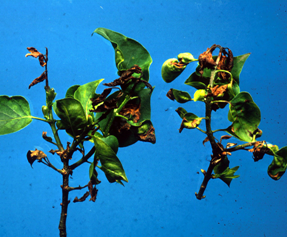
What is bacterial blight?
Bacterial blight, also known as blossom blight or shoot blight, is a common and often serious disease of Chinese, Japanese, Persian and common lilac, as well as walnut, apple, pear, plum and cherry. White flowering varieties of common lilac are most susceptible to the disease.
What does bacterial blight look like?
Initial symptoms of bacterial blight may include dark brown necrotic (dead) leaf spots with yellow halos. If leaf spots develop before leaves are fully expanded, leaf curling and twisting may result. More advanced symptoms include necrotic blotches starting at the leaf margins and advancing inward, as well as black streaking on twigs. In its most severe form, bacterial blight can result in the death of branch tips, leaves and blossoms.
Where does bacterial blight come from?
Bacterial blight is caused by the bacterium Pseudomonas syringae pv. syringae (Pss), which survives in diseased stem tissue (cankers), plant debris, and soil. Pss can be spread by insects and on pruning tools but is more commonly spread by wind and rain. Often Pss is found on the surface of healthy plants and does not cause disease. Infections can occur when the bacterium enters tissue through natural openings or through wounds caused by insects, pruning, wind damage or hail.
How do I save a plant with bacterial blight?
Prune diseased twigs 10 to 12 inches below the point of visible symptoms, and dispose of the branches by burning (where allowed by local ordinance) or burying them. Always prune in dry weather, and disinfest pruning tools after each cut by treating them for at least 30 seconds with a 10% bleach solution or preferably 70% alcohol (e.g., rubbing alcohol straight from the bottle or a spray disinfectant). If you decide to use bleach, be sure to thoroughly rinse and oil your tools after pruning is complete to prevent rusting.
How do I avoid problems with bacterial blight in the future?
When planting lilacs, provide adequate spacing between shrubs. Thin individual shrubs each winter to promote good air circulation (see University of Wisconsin Garden Facts XHT1015, Pruning Deciduous Shrubs, for pruning tips). Properly water, fertilize and mulch shrubs to avoid stress that may predispose them to disease. Avoid overhead watering that may keep leaves wet. If you have had chronic problems with bacterial blight, you may want to use a combination of copper and mancozeb-containing fungicides for control. Apply fungicides two to three times at seven to 10 day intervals as leaves emerge, but before symptoms develop. Read and follow all label instructions of the fungicide that you select to ensure that you use the fungicide in the safest and most effective manner possible.
For more information on bacterial blight:
Contact the University of Wisconsin Plant Disease Diagnostics Clinic (PDDC) at (608) 262-2863 or pddc@wisc.edu.
Authors: Gina Foreman* and Brian Hudelson, UW-Madison Plant Pathology
Last Revised: 02/28/2024
D-number: D0008
*Completed as partial fulfillment of the requirements for Plant Pathology 875 – Plant Disease Diagnostics Clinic Internship at the University of Wisconsin Madison.
References to pesticide products in this publication are for your convenience and are not an endorsement or criticism of one product over similar products. You are responsible for using pesticides according to the manufacturer’s current label directions. Follow directions exactly to protect the environment and people from pesticide exposure. Failure to do so violates the law.
Thanks to Ann Joy, Kristin Kleeberger and Mike Maddox for reviewing this document.
A complete inventory of UW Plant Disease Facts is available at the University of Wisconsin-Madison Plant Disease Diagnostics Clinic website: https://pddc.wisc.edu.
Send a Plant Sample for Analysis
Be cautious when self-diagnosing plant health issues. Very few diseases can accurately be diagnosed by eye.
Contact the UW Plant Disease Diagnostics Clinic (PDDC), and for a small fee, clinic staff can examine a plant, determine the cause of the disease/disorder, and provide advice on how to control or prevent the issue.
Download Article





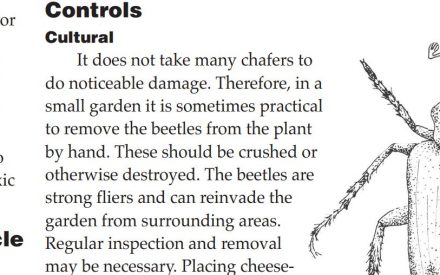 Deciduous Tree and Shrub Disorder: Skeletonizing by Rose Chafer
Deciduous Tree and Shrub Disorder: Skeletonizing by Rose Chafer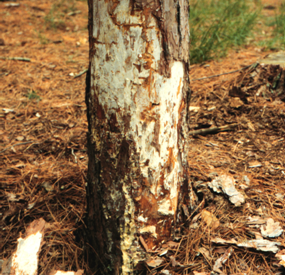 Armillaria Root Disease
Armillaria Root Disease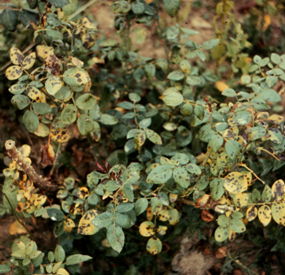 Black Spot
Black Spot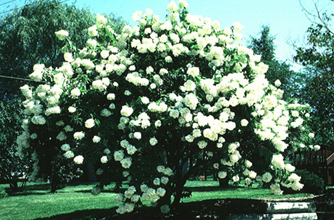 Summer Flowering Trees, Shrubs and Vines
Summer Flowering Trees, Shrubs and Vines


